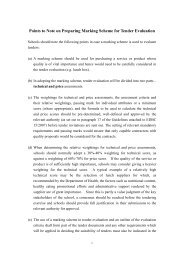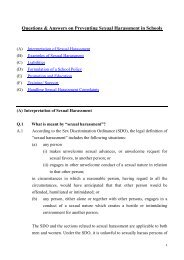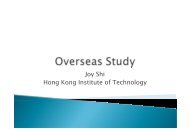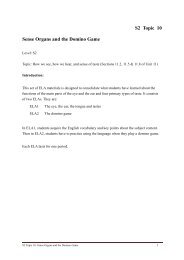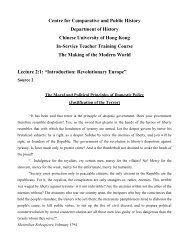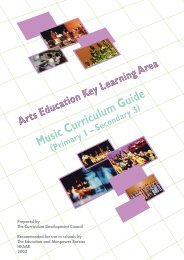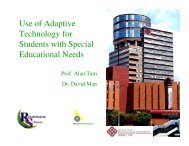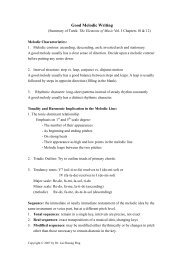Lecture 1.3 Intangible Cultural Heritage CHAU Hing-wah
Lecture 1.3 Intangible Cultural Heritage CHAU Hing-wah
Lecture 1.3 Intangible Cultural Heritage CHAU Hing-wah
Create successful ePaper yourself
Turn your PDF publications into a flip-book with our unique Google optimized e-Paper software.
<strong>Lecture</strong> <strong>1.3</strong><br />
<strong>Intangible</strong> <strong>Cultural</strong> <strong>Heritage</strong><br />
<strong>CHAU</strong> <strong>Hing</strong>-<strong>wah</strong><br />
1
<strong>Lecture</strong> Outline<br />
1<br />
<strong>Lecture</strong> <strong>1.3</strong> <strong>Intangible</strong> <strong>Cultural</strong> <strong>Heritage</strong><br />
Safeguarding of the <strong>Intangible</strong> <strong>Cultural</strong> <strong>Heritage</strong>: International Perspective<br />
International co-operation in preserving cultural heritage commenced in the 1930s. After<br />
years of discussion, the United Nations adopted a number of recommendations and<br />
declarations on the protection of <strong>Intangible</strong> <strong>Cultural</strong> <strong>Heritage</strong> (ICH) in the 1990s with<br />
extensive support from countries all round the world. In 2003, UNESCO adopted the<br />
Convention for the Safeguarding of the <strong>Intangible</strong> <strong>Cultural</strong> <strong>Heritage</strong> which promulgated the<br />
“Representative List of the <strong>Intangible</strong> <strong>Cultural</strong> <strong>Heritage</strong> of Humanity”. States Parties of the<br />
Convention then started to hold meetings to discuss the way forward in the safeguarding of<br />
ICH.<br />
� 1972. “Convention Concerning the Protection of the World <strong>Cultural</strong> and Natural<br />
<strong>Heritage</strong>”(《保護世界文化和自然遺產公約》)aims at preserving cultural heritage with<br />
outstanding universal value.<br />
� To counter balance the globalization.<br />
� 1989. “Recommendation for the Safeguarding of Traditional Culture and Folklore”(《保<br />
護傳統文化和民俗建議書》)<br />
� 1992. UNESCO advocated “<strong>Cultural</strong> Rights” in which ethnic minorities have the right to<br />
develop their own cultures.<br />
� 1998. UNESCO launched the programme of Proclamation of Masterpieces of the Oral<br />
and <strong>Intangible</strong> <strong>Heritage</strong> of Humanity.(人類口頭及非物質遺產傑作宣言)。<br />
� Nov 2001. “Universal Declaration on <strong>Cultural</strong> Diversity” of UNESCO(《世界文化多樣<br />
性宣言》)<br />
� May 2001. First Proclamation of 19 Masterpieces of the Oral and <strong>Intangible</strong> <strong>Heritage</strong> of<br />
Humanity.<br />
� 2003, 2005. Second and third proclamation of masterpieces.<br />
� Masterpieces in China: Kun Qu Opera, the Guqin and its music, the Uyghur Muqam of<br />
Xinjiang and the Traditional Folk Long Song Urtiin Duu (together with Mongolia).<br />
� Oct 2003. Adoption of “Convention for the Safeguarding of the <strong>Intangible</strong> <strong>Cultural</strong><br />
<strong>Heritage</strong>”(《保護非物質文化遺產公約》)<br />
� April 2006. The Convention was enacted. The first General Assembly of States Parties to<br />
the Convention was held in Paris in June, and 18 State Parties, including China, were<br />
elected as members of the Intergovernmental Committee for the Safeguarding of the<br />
<strong>Intangible</strong> <strong>Cultural</strong> <strong>Heritage</strong>. The first meeting of the Intergovernmental Committee was<br />
held in Algiers in Nov 2006 while the second was in China in May 2007. Two more
2<br />
<strong>Lecture</strong> <strong>1.3</strong> <strong>Intangible</strong> <strong>Cultural</strong> <strong>Heritage</strong><br />
extraordinary sessions of the Committee were held in Tokyo and the Republic of<br />
Bulgaria in Sept 2007 and Feb 2008 respectively. These sessions aimed at drafting<br />
Operational Directives.<br />
� June 2008. The second General Assembly was held in Paris. During the meeting, the<br />
Operational Directives of the Convention were adopted. States Parties were then<br />
requested to submit their applications for inscription on the List of the <strong>Intangible</strong><br />
<strong>Cultural</strong> <strong>Heritage</strong> of Humanity to the UNESCO before 30 Sept 2008.<br />
Definition of <strong>Intangible</strong> <strong>Cultural</strong> <strong>Heritage</strong><br />
The Convention for the Safeguarding of the <strong>Intangible</strong> <strong>Cultural</strong> <strong>Heritage</strong> defines ICH as<br />
follows:<br />
Article Two:<br />
1. The “<strong>Intangible</strong> <strong>Cultural</strong> <strong>Heritage</strong>” means the practices, representations, expressions,<br />
knowledge, skills – as well as the instruments, objects, artefacts and cultural spaces associated<br />
therewith – that communities, groups and, in some cases, individuals recognize as part of their<br />
cultural heritage. This intangible cultural heritage, transmitted from generation to generation,<br />
is constantly recreated by communities and groups in response to their environment, their<br />
interaction with nature and their history, and provides them with a sense of identity and<br />
continuity, thus promoting respect for cultural diversity and human creativity. For the<br />
purposes of this Convention, consideration will be given solely to such <strong>Intangible</strong> <strong>Cultural</strong><br />
<strong>Heritage</strong> as is compatible with existing international human rights instruments, as well as with<br />
the requirements of mutual respect among communities, groups and individuals, and is of<br />
sustainable development.<br />
2. The “<strong>Intangible</strong> <strong>Cultural</strong> <strong>Heritage</strong>”, as defined in paragraph 1 above, is manifested inter alia<br />
in the following domains:<br />
(a) Oral traditions and expressions, including language as a vehicle of the <strong>Intangible</strong> <strong>Cultural</strong><br />
<strong>Heritage</strong>;<br />
(b) Performing arts;<br />
(c) Social practices, rituals and festive events;<br />
(d) Knowledge and practices concerning nature and the universe;<br />
(e) Traditional craftsmanship.
Safeguarding of ICH at the National Level<br />
3<br />
<strong>Lecture</strong> <strong>1.3</strong> <strong>Intangible</strong> <strong>Cultural</strong> <strong>Heritage</strong><br />
The Convention for the Safeguarding of the <strong>Intangible</strong> <strong>Cultural</strong> <strong>Heritage</strong> formally came into<br />
force in April 2006 when it was ratified by the 30th country. States Parties are required to<br />
compile an inventory of the ICH present in their own territories for protection. The<br />
Convention also includes articles concerning the safeguarding and promotion of ICH, which<br />
provides a very useful guide for the States Parties to comply with.<br />
Article 12 – Inventories<br />
1. To ensure identification with a view to safeguarding, each State Party shall draw up, in a<br />
manner geared to its own situation, one or more inventories of the <strong>Intangible</strong> <strong>Cultural</strong><br />
<strong>Heritage</strong> present in its territory. These inventories shall be regularly updated.<br />
2. When each State Party periodically submits its report to the Committee, in accordance with<br />
Article 29, it shall provide relevant information on such inventories.<br />
Article 13 – Other measures for safeguarding<br />
Article 14 – Education, awareness-raising and capacity-building<br />
Article 15 – Participation of communities, groups and individuals<br />
Article 29 – Reports by the States Parties<br />
Safeguarding of ICH at the International Level<br />
The Convention established the “Representative List of the <strong>Intangible</strong> <strong>Cultural</strong> <strong>Heritage</strong> of<br />
Humanity”, the “List of <strong>Intangible</strong> <strong>Cultural</strong> <strong>Heritage</strong> in Need of Urgent Safeguarding” and the<br />
“<strong>Intangible</strong> <strong>Cultural</strong> <strong>Heritage</strong> Fund” to promote and to ensure better visibility of ICH and to<br />
offer technical and financial support to those countries in urgent need of safeguarding the<br />
disappearing ICH -<br />
Article 16 – Representative List of the <strong>Intangible</strong> <strong>Cultural</strong> <strong>Heritage</strong> of Humanity<br />
Article 17 – List of <strong>Intangible</strong> <strong>Cultural</strong> <strong>Heritage</strong> in Need of Urgent Safeguarding<br />
Article 25 – Nature and resources of the Fund<br />
Article 26 – Contributions of States Parties to the Fund
Article 27 – Voluntary supplementary contributions to the Fund<br />
Article 28 – International fund-raising campaigns<br />
Preservation of <strong>Intangible</strong> <strong>Cultural</strong> <strong>Heritage</strong> in China<br />
4<br />
<strong>Lecture</strong> <strong>1.3</strong> <strong>Intangible</strong> <strong>Cultural</strong> <strong>Heritage</strong><br />
China started her preservation work long before ratifying the Convention in 2004. The<br />
Ministry of Culture announced in September 2006 that the Chinese Academy of Arts(中國藝<br />
術研究院)in Beijing was accorded the title “The Protection Centre of <strong>Intangible</strong> <strong>Cultural</strong><br />
<strong>Heritage</strong> of China”. The State Council issued policy documents which requested that<br />
safeguarding of the ICH should be on an inter-ministerial basis and that the first territory-wide<br />
survey of ICH in China should be conducted, and a system for inscribing ICH on the national<br />
list should be established.<br />
� 1998. The set up of Center of Ethnic and Folk Literature and Art Development in<br />
Ministry of Culture, Peoples Republic of China.<br />
� Jan 2003. The Project of Preserving China’s Ethnic and Folk Culture was launched<br />
through collaboration between Ministry of Culture, Ministry of Finance, State Ethnic<br />
Affairs Commission and Chinese <strong>Cultural</strong> and Art Association. The project will be<br />
completed in 2020.<br />
� May 2002. The Chinese Academy of Arts convened a seminar on the Safeguarding of<br />
ICH in China and formally launched the Project of Identifying, Safeguarding and<br />
Protecting the ICH in China.<br />
� 8 Aug 2004. The Standing Committee of the 11 th National People’s Congress approved<br />
the submission of ratification document to UNESCO such that China became the sixth<br />
country to ratify the “Convention for the Safeguarding of the <strong>Intangible</strong> <strong>Cultural</strong><br />
<strong>Heritage</strong>”.<br />
� 26 March 2005. The State Council issued a policy document: “Directives on<br />
Strengthening the Protection of <strong>Intangible</strong> <strong>Cultural</strong> <strong>Heritage</strong> of Our Country”(《關於加<br />
強我國非物質文化遺產保護工作的意見》)which promulgated that:<br />
- Policy: Protection is the aim, salvaging comes first, reasonable use of the ICH resource,<br />
ensure transmission and succession.<br />
- Principles: Government Guidance, Society Participation, Explicit Responsibilities, Join<br />
forces Formation; Long-term Plan, Step-by-step Practice, Integration and Co-ordination,<br />
Promote Efficiency<br />
- Set up a liaison meeting system among 9 ministries for protecting ICH.<br />
- Establishment of a system of listing ICH at respectively national, provincial and county
5<br />
<strong>Lecture</strong> <strong>1.3</strong> <strong>Intangible</strong> <strong>Cultural</strong> <strong>Heritage</strong><br />
levels.<br />
� 22 Dec 2005. The State Council issued another policy document: “Notice on<br />
Strengthening the Protection of <strong>Cultural</strong> <strong>Heritage</strong>s”(《關於加強文化遺產保護的通知》)<br />
� May 2006. State Council announced the first national list of 518 items of ICH.<br />
� Sept 2006. The Ministry of Culture announced that the Chinese Academy of Arts was<br />
accorded the title “The Protection Centre of <strong>Intangible</strong> <strong>Cultural</strong> <strong>Heritage</strong> of China” so as<br />
to undertake the preservation of <strong>Intangible</strong> <strong>Cultural</strong> <strong>Heritage</strong> and conduct the<br />
territory-wide survey in China.<br />
� June 2008. State Council announced the second national list of 564 items of ICH.<br />
Preservation of <strong>Intangible</strong> <strong>Cultural</strong> <strong>Heritage</strong> in Hong Kong<br />
Following China’s ratification of the Convention, Hong Kong SAR Government designated<br />
the Home Affairs Bureau to be responsible for the safeguarding of <strong>Intangible</strong> <strong>Cultural</strong><br />
<strong>Heritage</strong> in Hong Kong. The Government is actively planning to conduct the first<br />
territory-wide survey of ICH in Hong Kong. An <strong>Intangible</strong> <strong>Cultural</strong> <strong>Heritage</strong> Advisory<br />
Committee was set up to advise the Government on the protection of <strong>Intangible</strong> <strong>Cultural</strong><br />
<strong>Heritage</strong>.<br />
� 2003. Guangdong, Hong Kong and Macau joined hands to apply to UNESCO for<br />
proclaiming Cantonese Opera as a masterpiece of “Oral and <strong>Intangible</strong> <strong>Heritage</strong> of<br />
Humanity”.<br />
� 2004. The Government of HKSAR (HKSARG) committed in November that the<br />
“Convention for the Safeguarding of the <strong>Intangible</strong> <strong>Cultural</strong> <strong>Heritage</strong>” would be<br />
applicable to the HKSAR and Home Affairs Bureau is the responsible policy bureau.<br />
� March 2006. An <strong>Intangible</strong> <strong>Cultural</strong> <strong>Heritage</strong> Unit was set up in the Hong Kong <strong>Heritage</strong><br />
Museum to undertake the preservation work in compliance with the Convention.<br />
� Oct 2006. The Chief Executive’s Policy Address stated that the government would<br />
“commission a study to compile a comprehensive inventory of Hong Kong’s <strong>Intangible</strong><br />
<strong>Cultural</strong> <strong>Heritage</strong> in accordance with the requirement of the UNESCO Convention for<br />
the Safeguarding of the <strong>Intangible</strong> <strong>Cultural</strong> <strong>Heritage</strong>, with a view to strengthening their<br />
preservation and promotion in Hong Kong”.<br />
� Oct 2006. The Hong Kong <strong>Heritage</strong> Museum commissioned the Division of Humanities<br />
of The Hong Kong University of Science and Technology to conduct a study of Hong<br />
Kong’s ICH with reference to the first provincial list of 78 items of ICH in Guangdong<br />
Province.<br />
� July 2008. An <strong>Intangible</strong> <strong>Cultural</strong> <strong>Heritage</strong> Advisory Committee was set up to advise the<br />
HKSAR on the conduct of the territory-wide survey.
<strong>Lecture</strong> Summary<br />
6<br />
<strong>Lecture</strong> <strong>1.3</strong> <strong>Intangible</strong> <strong>Cultural</strong> <strong>Heritage</strong><br />
The lecture mainly discusses three areas: (1) the definition of <strong>Intangible</strong> <strong>Cultural</strong><br />
<strong>Heritage</strong>; (2) how to preserve <strong>Intangible</strong> <strong>Cultural</strong> <strong>Heritage</strong> in Hong Kong; (3) the<br />
development of values and categories in the preservation of cultural heritage to include<br />
<strong>Intangible</strong> <strong>Cultural</strong> <strong>Heritage</strong>.<br />
(1) Definition and Historical Background of <strong>Intangible</strong> <strong>Cultural</strong> <strong>Heritage</strong><br />
Although it is a relative concept between <strong>Intangible</strong> and Tangible <strong>Cultural</strong> <strong>Heritage</strong>, the<br />
two categories are important parts of cultural heritage. Before 1970s, most nations only<br />
focused on preserving Tangible <strong>Heritage</strong> like historical buildings, monuments and<br />
archaeological relics. However, the Tangible <strong>Heritage</strong> refers to museums only if there is no<br />
human activity inside; so, the traditions and meanings in <strong>Intangible</strong> <strong>Cultural</strong> <strong>Heritage</strong> become<br />
part of preservation. As oral transmission is the major way of passing traditions of <strong>Intangible</strong><br />
<strong>Cultural</strong> <strong>Heritage</strong>, the target of preservation is not an object but human beings. A more precise<br />
explanation is the preserving of the people who pass the <strong>Intangible</strong> <strong>Cultural</strong> <strong>Heritage</strong> to the<br />
next generation.<br />
Japan is the first country to start preserving <strong>Intangible</strong> <strong>Cultural</strong> <strong>Heritage</strong>. In 1950, it<br />
passed a law about preserving <strong>Intangible</strong> <strong>Cultural</strong> <strong>Heritage</strong> as “Invisible <strong>Cultural</strong> <strong>Heritage</strong>”<br />
(無形文化遺產), in which “invisible” means “intangible forms”. In 1962, South Korea also<br />
passed a law to preserve its <strong>Intangible</strong> <strong>Cultural</strong> <strong>Heritage</strong>.<br />
What is <strong>Intangible</strong> <strong>Cultural</strong> <strong>Heritage</strong>? The example of Kushida Shrine in Fukuoka City in<br />
Japan elaborates the definition. In Kushida Shrine, there is a five metre tall Kazariyama; the<br />
inscription of a stele next to it is carved with the words “guo zhongyao wuxing minzu wenhua<br />
cai” (Important <strong>Intangible</strong> <strong>Cultural</strong> Asset of Nation 國重要無形民族文化財). In this major<br />
festival every year, the local people patrol with portable shrines is an intangible and invisible<br />
medium of tradition by a particular group of people in a particular time and location. So, the<br />
medium of this invisible cultural tangible is the people; the preservation is for their activities,<br />
the location and the space of this activity. Another example is the wedding system in Japan.<br />
Many Japanese still hold their wedding ceremonies in shrines. The procedures and<br />
participants form an invisible cultural tradition in Japan. These wedding ceremonies are still<br />
held in Kushida Shrine, part of Shinto in Japan which is a more ancient religion than<br />
Buddhism. The wedding rituals in this shrine are the intangible cultural traditions passed
7<br />
<strong>Lecture</strong> <strong>1.3</strong> <strong>Intangible</strong> <strong>Cultural</strong> <strong>Heritage</strong><br />
through every participant. At the end of the wedding ceremonies, the participants leave and<br />
only the building of the shrine remains. We can never understand the meanings of these<br />
traditional activities without the knowledge of how people use this historical building.<br />
In 1972, UNESCO enforced the “Convention Concerning the Protection of the World<br />
<strong>Cultural</strong> and Natural <strong>Heritage</strong>”(《保護世界文化和自然遺產公約》)which is focused on<br />
Tangible <strong>Cultural</strong> <strong>Heritage</strong> but not the intangible ones. The Convention had great impact on<br />
the worldwide efforts on preserving cultural heritage; there are more than 800 heritage with<br />
outstanding universal value included in the list of World <strong>Heritage</strong>s. As World <strong>Heritage</strong> is the<br />
facilitator of cultural tourism which encourages regional economic development, there has<br />
been “hot application of <strong>Intangible</strong> <strong>Cultural</strong> <strong>Heritage</strong>” in China in recent years.<br />
In the 1980s, it is discovered that some local traditions were not preserved and disappear<br />
rapidly in the globalization process. The global economic integration has been a way to<br />
counter-balance the globalization. It is a fact that a strong economy supersedes a weak<br />
economy and the same goes for cultures.<br />
The cultural shock is vigorous; many nations especially small countries advocate the<br />
protection of marginalized cultures and preserve the cultural diversity as a resistance. The<br />
meaning of <strong>Intangible</strong> <strong>Cultural</strong> <strong>Heritage</strong> is that there is no high or low culture so every culture<br />
enjoys the right to transmit through generations. In 1989, the United Nations passed<br />
“Recommendation for the Safeguarding of Traditional Culture and Folklore”《保護傳統文化<br />
民俗建議書》and promoted the concept of “<strong>Cultural</strong> Right” in 1992.<br />
“<strong>Cultural</strong> Right” by United Nations enshrines the right of every ethnic minority to<br />
develop their culture and not be eliminated by strong cultures. Language is an example. There<br />
are only about 6700 languages in the contemporary world according to the statistics of United<br />
Nations, though there were more than ten thousand languages in the past. Languages are the<br />
roots of the ethnic groups which show their expressive patterns and particular cultures. Since<br />
no one protects the marginalized languages, a language dies out as the speakers decrease in<br />
number. For example, there are different dialects like Hakka, Punti, Tanka used by different<br />
ethnic groups in Hong Kong; in the recent years, Cantonese assimilate these languages and<br />
becomes a major language. There are six official languages in the United Nations so that most<br />
of the world population are using these languages; the remaining six thousand languages are<br />
used by a small number of people and disappear faster than before.<br />
In 1998, UNESCO launched the programme of Proclamation of Masterpieces of the Oral<br />
and <strong>Intangible</strong> <strong>Heritage</strong> of Humanity(《宣佈人類口頭及非物質遺產傑代表作》)the purpose
8<br />
<strong>Lecture</strong> <strong>1.3</strong> <strong>Intangible</strong> <strong>Cultural</strong> <strong>Heritage</strong><br />
of which is to create a list for people to recognize the importance of intangible cultural<br />
heritage and local traditions. UNESCO announced the first proclamation of 19 masterpieces<br />
of the Oral and <strong>Intangible</strong> <strong>Heritage</strong> of Humanity 人類非物質文化遺產代表作 in May, 2001.<br />
There are 19 masterpieces and Kun Qu Opera of China is included. In 2003 and 2005, there<br />
are two more lists and the number of masterpieces increased to 90. There are four<br />
masterpieces from China: Kun Qu Opera (2001), the Guqin and its music (2003), the Uyghur<br />
Muqam of Xinjiang (2005) and the Traditional Folk Long Song Urtiin Duu (together with<br />
Mongolia) (2005). China has the highest number of masterpieces of the Oral and <strong>Intangible</strong><br />
<strong>Heritage</strong> of Humanity in the world.<br />
The programme stopped soon afterwards. In October 2003, UNESCO adopted<br />
“Convention for the Safeguarding of the <strong>Intangible</strong> <strong>Cultural</strong> <strong>Heritage</strong>” 《保護非物質文化遺<br />
產公約》and it was enforced in April, 2006. The definition of <strong>Intangible</strong> <strong>Cultural</strong> <strong>Heritage</strong> in<br />
this convention includes the cultural practices, performances, knowledge, skills and local<br />
traditions. The definition has to satisfy two criteria: (1) it lasts for a long period, passing<br />
through generations; (2) the subject is an ethnic group or individual who builds up their sense<br />
of belonging, identity and historical consciousness in the passing of intangible cultural<br />
heritage. There are five domains in the convention, including (1) oral traditions and<br />
expressions, including language as a vehicle of the <strong>Intangible</strong> <strong>Cultural</strong> <strong>Heritage</strong>; (2)<br />
performing arts; (3) social practices, rituals and festive events; (4) knowledge and practices<br />
concerning nature and the universe; and (5) traditional craftsmanship.<br />
In Hong Kong, the five categories of <strong>Intangible</strong> <strong>Cultural</strong> <strong>Heritage</strong> include the following<br />
content. Oral traditions and expressions comprise Cantonese, Hakka, Waitou, Tanka and<br />
Hoklo dialects which are dying out rapidly; oral traditions like the story of Cheung Po Tsai,<br />
myth of Yeung Hau, princess story of Tang lineage of Lung Yuek Tau, story of Pui To<br />
Buddhist. The second category of performing arts includes Cantonese Opera, Naamyam,<br />
Puppet Opera, Chaozhou Opera of Hungry Ghost Festival. Cantonese opera once declined<br />
between 1970s and 1990s; however, the government gives some resources to promote it as<br />
education and so it tends to revive. Guangdong, Hong Kong and Macau have cooperated to<br />
apply to the UNESCO to enlist Cantonese Opera in masterpieces of the Oral and <strong>Intangible</strong><br />
<strong>Heritage</strong> of Humanity. Examples of local customs are ancestral rites of lineages in the New<br />
Territories, dragon boat parade of Tai O fishermen, Hungry Ghost Festival, Tin Hou Festival<br />
in Sai Wan of Cheung Chau, Tin Hou Festival of Shap Pat Heung, Birthday of Patron Saint of<br />
Expectant Mothers, Jiao festival of Cheung Chau, Shek O, Tai Long Wan and Kut O. These<br />
activities change in history but follow the major functions and meanings. However, they face<br />
difficulties like the people to inherit and their activity space gradually disappears under urban<br />
development. The fourth category includes the understanding of people to their cosmos world,
9<br />
<strong>Lecture</strong> <strong>1.3</strong> <strong>Intangible</strong> <strong>Cultural</strong> <strong>Heritage</strong><br />
like the customs of Tai Sui, villain hitting and Wishing Tree of Lam Tsuen; though these<br />
activities are categorized as superstition, they are the mediums of Chinese value systems and<br />
customs. The fifth category of traditional handicraft contains putting up a shed, basking<br />
shrimp paste, knowledge of weaving seine, street side food stall, basin meal, old market and<br />
so forth; some are disappearing and some have undergone great changes in meanings. Herb<br />
tea is enlisted in the <strong>Intangible</strong> <strong>Cultural</strong> <strong>Heritage</strong> at state level and so enjoys a revival.<br />
(2) Safeguarding Measures for <strong>Intangible</strong> <strong>Cultural</strong> <strong>Heritage</strong><br />
According to “Convention for the Safeguarding of the <strong>Intangible</strong> <strong>Cultural</strong> <strong>Heritage</strong>”, the<br />
participant countries are required to create a list of their intangible cultural heritages. The list<br />
requires researches and surveys, such as the census conducted in Hong Kong. Another step is<br />
to form a mechanism for protection. UNESCO established the “Representative List of the<br />
<strong>Intangible</strong> <strong>Cultural</strong> <strong>Heritage</strong> of Humanity”, the “List of <strong>Intangible</strong> <strong>Cultural</strong> <strong>Heritage</strong> in Need<br />
of Urgent Safeguarding” for national application. The “List of <strong>Intangible</strong> <strong>Cultural</strong> <strong>Heritage</strong> in<br />
Need of Urgent Safeguarding” sets up an emergency fund by the countries to provide funding<br />
and technical assistance to preserve the heritage of small and poor countries. The third step is<br />
an Intergovernmental Committee by the participant countries in June, 2006 and 2008; the<br />
meetings established and enforced the Safeguarding of the <strong>Intangible</strong> <strong>Cultural</strong> <strong>Heritage</strong>.<br />
In 1980s and 1990s, China participated in the making of convention. China became one<br />
of the countries to ratify the convention in 2004 and the State Council issued “Directives on<br />
Strengthening the Protection of <strong>Intangible</strong> <strong>Cultural</strong> <strong>Heritage</strong> of Our Country”(《關於加強我<br />
國非物質文化遺產公約的意見》)in 2005. A liaison meeting system among 9 ministries was<br />
set up for protecting <strong>Intangible</strong> <strong>Cultural</strong> <strong>Heritage</strong>; also, a system of listing <strong>Intangible</strong> <strong>Cultural</strong><br />
<strong>Heritage</strong> at respectively national, provincial and county levels was established. A national<br />
census of <strong>Intangible</strong> <strong>Cultural</strong> <strong>Heritage</strong> was carried out from 2005. In September 2006, the<br />
Chinese Academy of Arts was appointed to be the centre of practical measures on census,<br />
researches and protections.<br />
In 2006, the State Council announced the first national list of 518 items with Cantonese<br />
Opera and herb tea by Guangdong, Hong Kong and Macau. In 2008, another list of 510 items<br />
was announced.<br />
To match up the work of the convention, the Hong Kong government set up the<br />
<strong>Intangible</strong> <strong>Cultural</strong> <strong>Heritage</strong> Unit under Hong Kong <strong>Cultural</strong> Museum in March 2006. A<br />
territorial-wide survey is proposed for the first proclamation. Also, in July 2008, the
10<br />
<strong>Lecture</strong> <strong>1.3</strong> <strong>Intangible</strong> <strong>Cultural</strong> <strong>Heritage</strong><br />
government set up the <strong>Intangible</strong> <strong>Cultural</strong> <strong>Heritage</strong> Advisory Committee of ten professionals<br />
and scholars to monitor the census and provide suggestions to the government on protective<br />
measures. After the listing, the government creates a series of protective measures of<br />
researches, preservation, promotion, education and reviving.




